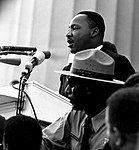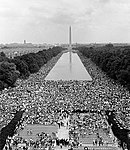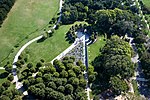John Ericsson Memorial

John Ericsson Memorial, located near the National Mall at Ohio Drive and Independence Avenue, SW, in Washington, D.C., is dedicated to the man who revolutionized naval history with his invention of the screw propeller. The Swedish engineer John Ericsson was also the designer of USS Monitor, the ship that ensured Union naval supremacy during the American Civil War.The memorial was authorized by Congress August 31, 1916, and dedicated May 29, 1926 by President Calvin Coolidge and Crown Prince Gustaf Adolf of Sweden. Congress appropriated $35,000 for the creation of the memorial, and Americans chiefly of Scandinavian descent raised an additional $25,000. Constructed on a site near the Lincoln Memorial between September 1926 and April 1927, the pink Milford granite memorial is 20 feet (6.1 m) high with a 9-foot (2.7 m) diameter base. Sculpted by James Earle Fraser, it features a seated figure of Ericsson 6 feet 5 inches (1.96 m) high, and three standing figures representing adventure, labor, and vision. The national memorial is managed by National Mall and Memorial Parks.
Excerpt from the Wikipedia article John Ericsson Memorial (License: CC BY-SA 3.0, Authors, Images).John Ericsson Memorial
Ohio Drive Southwest, Washington
Geographical coordinates (GPS) Address External links Nearby Places Show on map
Geographical coordinates (GPS)
| Latitude | Longitude |
|---|---|
| N 38.886666666667 ° | E -77.050277777778 ° |
Address
John Ericsson National Memorial
Ohio Drive Southwest
20024 Washington
District of Columbia, United States
Open on Google Maps










